Welcome to the Mabon Blog Hop! Hopefully you’ve just come from Amanda Levesque’s blog and will head over to Morgan Drake Eckstein’s blog next. You can also check out the master list of all the blogs in the hop.
Our theme this time around is Divination and Myth. Which gives me a chance to explain why two of my favorite decks are decks that my clients never ask me to read from — and maybe also explains why these decks are not so popular with my clients.
First, the Samurai Tarot, by Lo Scarabeo. I adore this deck, for several reasons, but most of all because it is an extremely spiritual deck. Like the Yoga Tarot, this deck includes several cards that show people meditating. All the kings in the deck are monks — and since the Samurai Tarot’s court cards are actual people from Japanese history, the monks that represent the kings are real people:
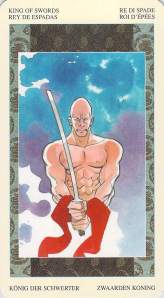
Takuan, the King of Swords, from the Samurai Tarot Takuan, the King of Swords, the monk who hung famous swordfighter Miyamoto Mushashi in a tree for several days and then imprisoned him in an attic for three years so that he could overcome his ego. (Musashi is in this deck too: the Knight of Swords — who else could he be?)
- Nichiren, the King of Chalices, a monk who was at one point in his life arrested by soldiers who tried to behead him, but who were stopped at the last minute by a luminous orb of light which terrified the soldiers and resulted in Nichiren’s sentence being commuted to exile.
- Kukai, the King of Pentacles, who myths and legends tell us is still alive, on Mount Koya, awaiting the appearance of the next Buddha Maitreya
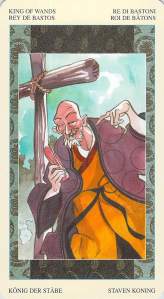
Shikoden, the King of Wands, from the Samurai Tarot Shikoden, the King of Wands, a monk about whom I could find very little information except for an intriguing reference to his quirky sense of humor and habit of carrying around a wooden phallus which he would occasionally bang on the table to make a point.
In addition, two of the queens in this deck are writers (ahem! storytellers!):
- novelist Murasaki Shikibu, the Queen of Wands
- poet Ono no Komachi, the Queen of Chalices (my personal favorite poet ever!)
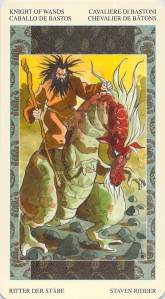
Then there are the knights’ stories: swordfighter Miyamoto Musashi; Shoki, the hunter of demons; Minamoto Yoritomo, the first Shogun…and notable among the knaves, Oboshi Yuranosuke, leader of the 47 ronins.
In other words, this is a deck in which every card has a story, and the better you know the story, the better you can understand what that particular card means to you. These are stories from Japanese history, which I don’t know well at all, so I’ve had to chase down the stories a few at a time — and each one always turns out to be a pearl that enriches my reading immeasurably. I’m starting to feel that I need to come up with stories that go with the court cards in my more popular Universal Waite deck — they seem so ordinary by comparison!
Why do these stories help me to interpret a reading? Because they take a two-dimensional image and extend it into other dimensions: time, space, character, plotlines. Suddenly there’s a network of information where before there was only a sense of something, a symbol, a color. It’s the difference between getting just a glimpse of what a card may mean and getting an entire tapestry of food for thought. (I guess I’m greedy that way…)
Does it matter if the stories that go with a deck are old legends and myths? Can a deck function in an equally rich way if the story is from a recent novel? Based on my experience with Colette Baron-Reid’s Wisdom of the House of Night cards, the answer is yes. This deck is based on a young adult novel series: basically Harry Potter, but with vampires. Yes, vampires. I’m not the type for a vampire deck, but yet…these cards are rich with possibility. In this case, each card is not a story, but each carries a part of the larger story of the deck: the story of adolescence (a stage that to some degree, none of us have ever grown out of–so this deck is definitely NOT only relevant to teens). Consider these examples:
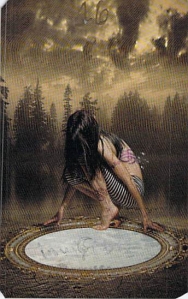
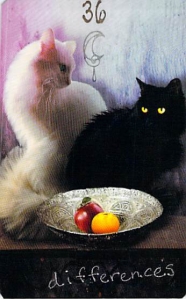
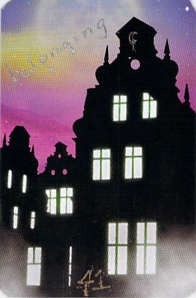
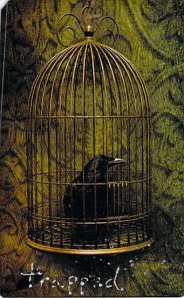

Since these two decks are rich with possibility, why aren’t they so popular with my clients? Um, vampires? Samurai? Sounds violent…or at least, it sounds like the shadow side. These decks have SO much to say, and though they are not full of violence, they do speak of the shadow side. The Samurai Tarot’s suit of wands is full of ghosts, as a matter of fact. But–no story, and no life, can be just happiness and fluff. Our lives are rich with shadows. We carry with us ghosts from our past. We carry with us demons. Ironically enough, these decks that recognize the shadow side are also rich with hope and with positive ways to approach the shadows — both decks are meditation pushers, both are full of cards advocating being awake, aware, and full of courage. And without the shadows, without the full story, we can’t really see the full picture. But isn’t that what divination is for? Seeing clearly?
Don’t forget to go back and read Amanda Levesque’s blog, if you haven’t already, or head forward to Morgan Drake Eckstein’s blog next. Or, take a moment to view the master list of all the blogs in the hop (there are 25 of us this time around!)

Loved your post… you’ve awoken a bit of deck lust… I can see myself having a chat with that King of Wands 😀 thanks!
LikeLike
lol, Serves you right for getting me interested in the Thoth… 🙂 Glad you liked the post!
LikeLike
That’s the kind of payback I can live with 😀 seems fair enough…
LikeLike
Loved your post, and also the inside views into some of the decks you use 🙂 I’ve heard of the Samurai deck but haven’t seen images of it!
LikeLike
Thanks! I have lots of images of the Samurai Tarot on the site…
LikeLike
Thank you. I love the Asian style decks. Haven’t pulled out my Samurai in while. 😀
LikeLike
You are welcome! 🙂
LikeLike
Great post! For one I love your name, Tarot Salve, yay. And, I too have decks that I adore that have so much depth and greatness that do not get a lot of client attention. I need to check out that Samuari deck it looks fantastic.
LikeLike
Thanks! So glad you liked the post! 🙂
LikeLike
Lovely, lovely post! I hadn’t heard of either of those decks so thank you for the introduction! I also love tales being woven into the cards. The dimensions become limitless when story is involved. Both of these decks look wonderful – I’m particularly drawn to Wisdom of the House of Night.
LikeLike
Me too. I especially like this deck because I trimmed the borders off it and rounded the corners, and now it fits my small hands just perfectly…I am fascinated by the stories of both decks and just can’t get enough of them.
LikeLike
Wonderful introduction to two decks that I don’t know…thank you!
LikeLike
You’re welcome–I’m so glad you liked the post!
LikeLike
Samurai deck in particular is cool. I assume from what you wrote that the stories were not given by the deck’s LWB or equivalent, but that you had to do some research. A worthy cause, I think. I wouldn’t want to read that deck without knowing the stories behind the characters. I never thought about the RWS deck being shallow in that sense, but I suppose it is—the lack of a theme has minuses as well as pluses, now that I think about it. Very enlightening post, and the Samurai deck a very tempting prospect. 🙂
LikeLike
Thanks! I’m sorry I didn’t see this comment earlier–I’ve been offline quite a bit lately. I agree with you about the pluses and minuses. Lately I am feeling drawn to combining decks for exactly this reason–sometimes for a three-card reading I will draw a couple of cards from the Universal Waite, and then a clarifying card from a different deck like the Samurai Tarot. Other times I will go a different direction and do a side by side tarot and Lenormand reading to see how each clarifies the other. Maybe I just like to play with these different decks, lol…
LikeLike